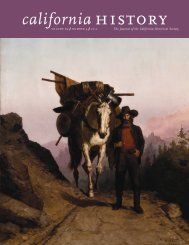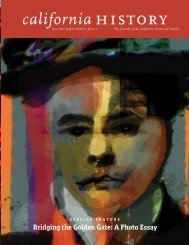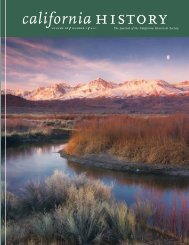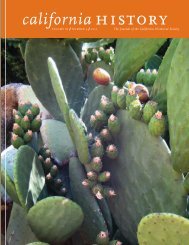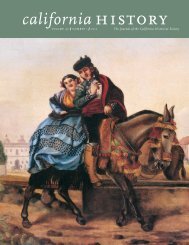california history - California Historical Society
california history - California Historical Society
california history - California Historical Society
You also want an ePaper? Increase the reach of your titles
YUMPU automatically turns print PDFs into web optimized ePapers that Google loves.
A hundred students, activists, and local residents participated in the creation of People’s Park on April 20. Stew Albertdescribed the park’s first day: “People were really happy. The sense of victory of having eliminated something ugly, of justdoing something that was uncompromising and truthful was a very powerful trip. . . . What we were creating was our owndesires, so we worked like madmen and loved it.”<strong>California</strong> <strong>Historical</strong> <strong>Society</strong>; photograph by Gordon Peterssod. A celebration then commenced, as workersdistributed communally prepared free foodand listened to the music of the Joy of Cooking,which satisfied Delacour’s original motivation forconceiving the park. Schlesinger was enthusedover what she perceived as a new style in dancingpatterns: “People whirled around barefoot, folkdancing together in a circle at a million miles anhour, going back to the jungle tribe. None of thepsychedelic crap.” 26For the next three weeks, People’s Park continuedto take shape and gain support. Althoughhe had composed the original Barb appeal, StewAlbert, concerned that his political radicalismmight negatively affect the turnout, had optednot to sign it. However, the paper’s April 25 issueincluded Albert’s account of the first day of parkbuilding, which placed Black Panther chairmanBobby Seale on the scene “laughing in total andhappy amazement” and portraying People’s Parkas “really socialistic.” Albert also announced that,although “anytime you want to work is the timeto come to the Park,” Sunday, April 27, wouldbe “our next big Commune Day.” A thousandparticipants, ten times as many as the previousweek, worked in People’s Park that Sunday, provingthat in Berkeley radicalizing the park issuewas not a deterrent to involvement. 27On May 9, the Barb also published Frank Bardacke’sdefense, “Who Owns the Park?,” a manifestoeven more overtly political. In his closingremarks, Bardacke threw down the gauntlet: “We16<strong>California</strong> History • volume 88 number 1 2010



